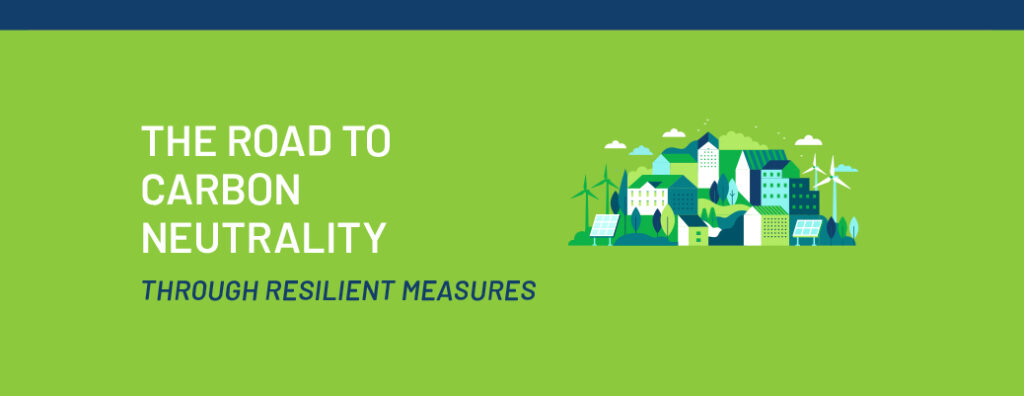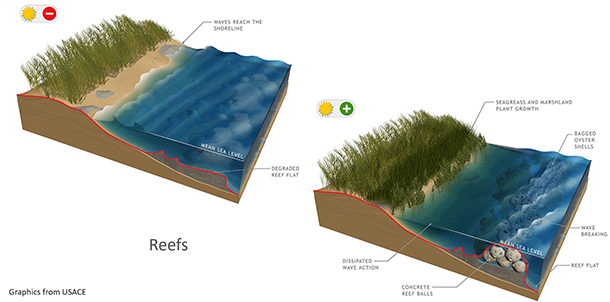
re·sil·ience
- the capacity to recover quickly from difficulties; toughness
- the ability of a substance or object to spring back into shape; elasticity
Resilience is an important priority today and will become even more important in the years ahead as climate change continues to intensify. Until recently, the Earth had been very resilient, adjusting and balancing many critical variables to sustain a healthy ecosystem and atmosphere. Now it’s our turn to help the Earth be more resilient!
Our world, and our coastal cities in particular, have seen climate change lead to major destruction often in some of our most heavily-populated areas. With over 40% of the US population living in coastal communities, we stand to endure more natural disasters. Since 2014, the United States has seen nine major hurricanes, over 150 wildfires, and over 170 flood events.
Recently, I gave a presentation at the American Public Works Association (APWA) annual conference in Norfolk, Virginia, on resiliency as it relates to Sea Level Rise. I spoke about the effects of Superstorm Sandy, Hurricane Irene, and Tropical Storm Lee which led to the creation of two very large disaster recovery programs created in New Jersey and New York. Over the past 5+ years, we have been an integral part of the NJ Reconstruct, Rehabilitate, Elevate and Mitigate (RREM) and NY Governor’s Office of Storm Recovery (GOSR) programs. Our expertise in program management, construction management, and information technology allowed us to develop detailed workflows for each program identifying the critical interphases throughout the NJ-RREM Single Family Home and Rental Programs along with the NY-GOSR Small Business Program and Condo Co-op Program. Through this work, I continue to stress the importance of creating well-written policies and procedures that address the immediate housing needs of storm-impacted communities and small businesses by promoting economic development through sustainable and resilient construction and pursuing a community-wide and regional approach toward coastal community resiliency.
There is a lot of work to be done. One key area to focus on is carbon neutrality. We have a challenging, but exciting, opportunity to discover and learn together how we can respond to the increase of the relentless rise of carbon emissions in our atmosphere which in turn has many ripple effects that are contributors to today’s natural disasters. Where to start? So many questions come to mind. Here are just a few:
- What is carbon neutrality and how does it relate to resiliency?
- What are some examples of resiliency as it relates to coastal flooding?
- What can we do to enhance carbon neutrality?
What is carbon neutrality and how does it relate to resiliency?
Think of the Earth’s atmosphere as a delicate balance of gases that helps sustain life as we know it. If there is too much CO2 in the atmosphere or an imbalance of other greenhouse gases, the earth’s temperature will rise and cause many complications. If carbon emissions reach a certain level, there may be irreversible damage to the earth’s atmosphere jeopardizing the very existence of our beautiful planet.
It is important for society today to understand the importance of resiliency as it relates to carbon neutrality. It all starts with the individual becoming aware of the burning of fossil fuels which are emitting large amounts of CO2 into the air. Together we can work with science to create alternate renewable fuel sources, rewrite the local building codes to adopt more resilient measures in the future, and redesign existing infrastructure to adapt to the changing climate, and ultimately creating a new economy that is resilient to climate change.
To be carbon neutral means you must use 100% renewable energy achieving net zero emissions of CO2 across the entire value chain of your business. If you are not able to remove carbon from your footprint you can purchase renewable offsets. Urbanization is happening at a rapid pace in cities around the globe, creating environmental, social, and economic challenges. In response, some citizens are stepping up to push forward and accelerate the shift to a clean energy economy.
What are some examples of resiliency as it relates to coastal flooding?
Resiliency is the ability to endure, withstand, and bounce back into shape. An example of this could be to implement a living shoreline in an area being depleted of land due to sea level rise, coastal erosion, or recent hurricane/storm damage. A living shoreline utilizes many different stabilization techniques depending on the types of waters they will be designed for, such as sheltered shorelines, tributaries, estuaries, or bays. This technique is not intended for beaches on the open ocean.
Example of a Resilient Coastal Living Shoreline

This new resilient approach on stabilization options is gaining attention as an alternative to traditional, harder shoreline stabilization techniques, such as bulkhead and seawall construction. Living shorelines can reduce damage and erosion while simultaneously providing a healthy ecosystem, including cleaner and nutrient-rich waters. Living shorelines can also increase food production and decrease sediment removal along the coast. They are mostly made up of native material incorporating natural vegetation elements with some harder types of shoreline structures like oyster beds/reefs and rock sills.
We continue to help applicants understand and navigate the processes for receiving community development block grant (CDBG) funding for living shorelines via the NY GOSR Small Business Program. Some of the small businesses have decided to implement a living shoreline technique to help mitigate further damage and provide resiliency within their shoreline. We work closely with applicants to ensure their scopes of work align with their estimated cost of repair and have been implemented correctly into their new design while making sure applicants adhere to the program requirements and are receiving the correct grant funding.
What can we do to enhance carbon neutrality?
Aim to eliminate carbon from your business
- Utilize monitoring-based building commissioning – this is the process of using sensors to collect, store, analyze, and understand data to optimize a buildings performance ultimately reducing the amount of carbon that is emitted into the atmosphere
- Address embodied carbon in building materials and the construction processes – this starts by understanding what types of products are being sourced, where they are coming from, and how they are made
Understand climate change risks to your business and develop a climate change adaptation plan
- Facility management
- Promote renewable energy on-site and off-site
- Carbon Neutrality Master Plan
Use science-based targets to understand your real contribution to climate change, measure and manage progress towards a decarbonized economy
- Promote carbon-smart building best practices and policies
- Design high-performance buildings
- Renovate existing buildings to meet high-performance standards
Many states and municipalities are working to create a new sustainable resilient economy and infrastructure. At the state level, for example, New York signed into law last month to move towards 85% reduction in greenhouse gas emissions by 2050, as well as net zero emissions by all sectors of the economy. This will move the city towards using greener sources of energy while at the same time reducing energy use. By continuing to stress proactive thinking and taking preventative measures to address and mitigate risk, we can better understand how climate change will affect the safety of individuals, facilities, and infrastructure.
Learn about our facility performance consulting services and contact us if you need help meeting your sustainability goals.



